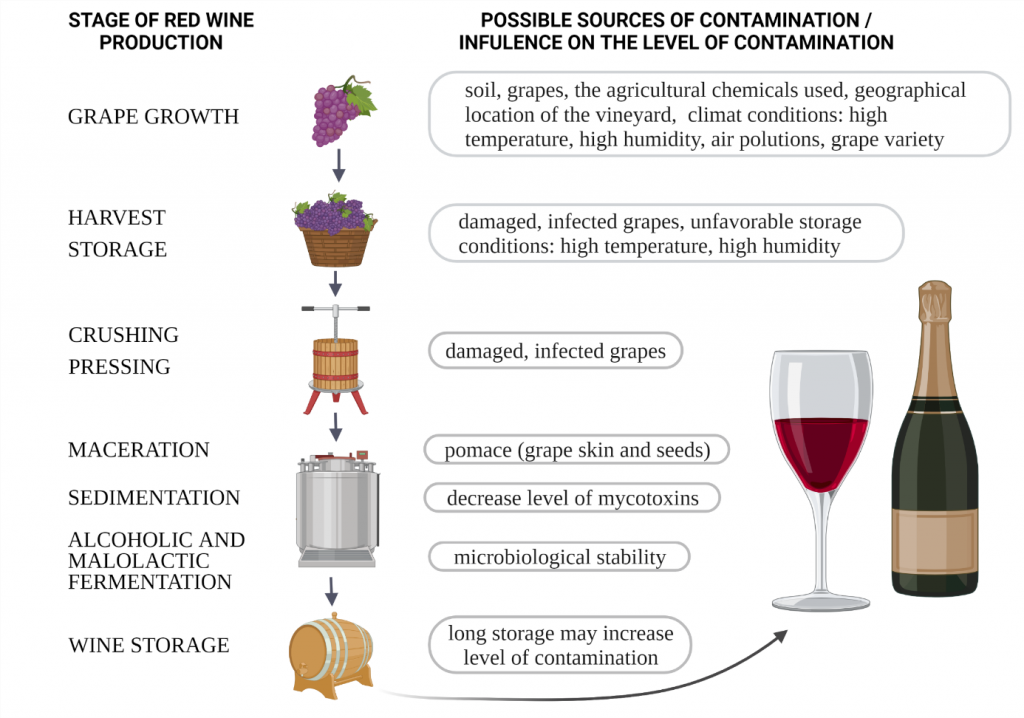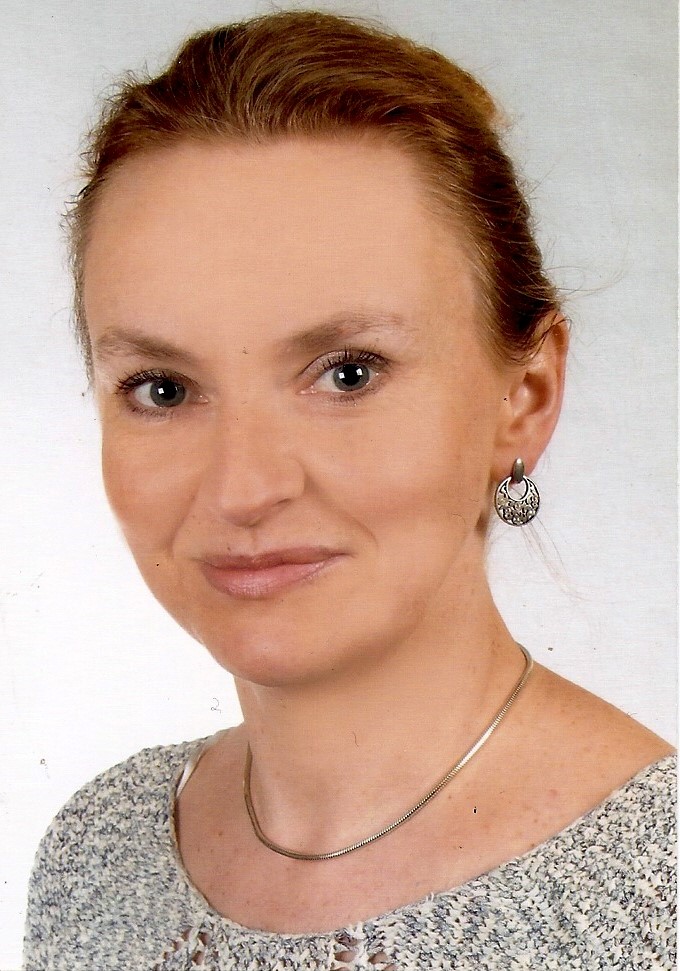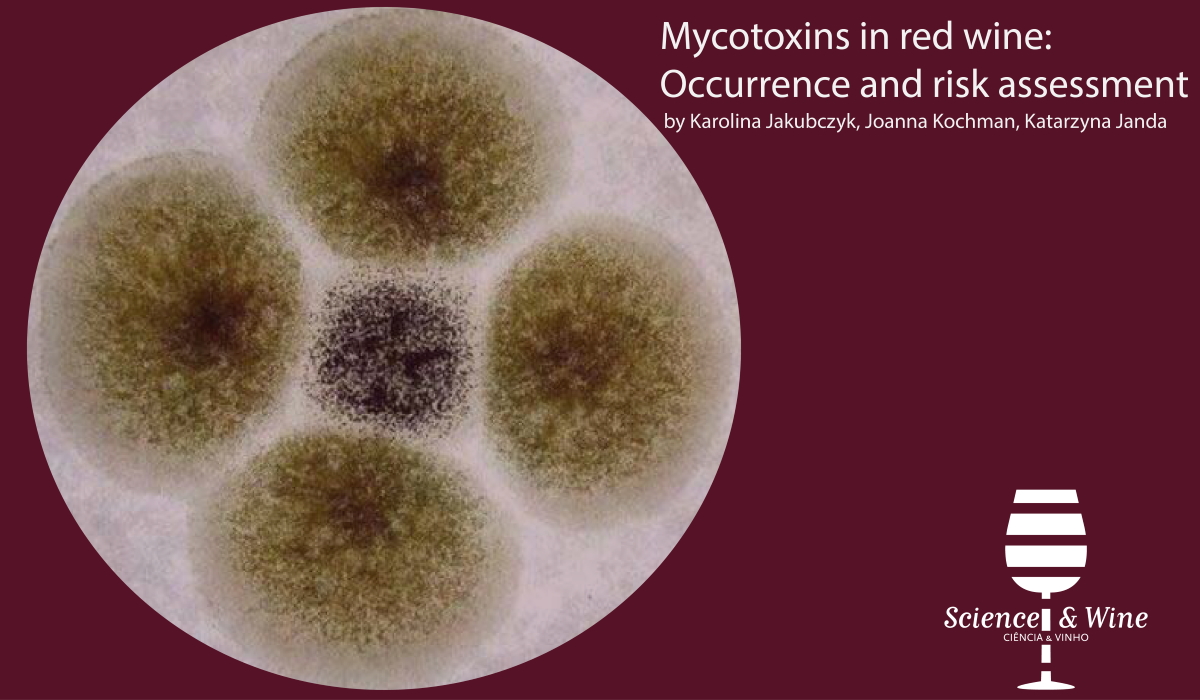Karolina Jakubczyk (FitoScience), Joanna Kochman, Katarzyna Janda
Mycological contamination of food products is a common problem in the food industry, associated with implications for consumer health. Red wine is regarded as an alcoholic beverage with health benefits, notably for the circulatory system. However, in spite of its health-promoting properties, it can also be a source of toxic substances. Wine is a documented source of ochratoxin A, which is one of the ubiquitous, highly toxic secondary metabolites produced by filamentous fungi. It is the only mycotoxin for which a regulatory maximum level in wine has been established. There are no legal regulations on the content of other mycotoxins in wine, as a product with an increased risk of mycological contamination, and so their levels are not monitored (1). The sources of mycotoxin contamination may be different during the wine production stages, in addition, especially the stages of the red wine vinification process may also influence the level of their contamination (1,2).

The daily amount of wine recommended due to health benefits may pose a threat of exposure to mycotoxins and their adverse effects on the human body, seeing as the concentrations of ochratoxin A and deoxynivalenol were observed to be considerably higher than the exposure limits for food products. The mean contamination level in Polish wines amounted to 6.629 µg/L, in Spanish wines 6.848 µg/L, and in the wines from France 6.711 µg/L. The concentration of OTA in all of the samples of wine significantly exceeded the regulatory limit established for wine, amounting to 2 µg/L (3). Sample contamination with deoxynivalenol exceeded the established limit (0.75 mg/L) (4) in 100% of the wine samples, irrespective of the country of origin. The mean concentration of DON in the wines grown in Poland amounted to 1.696 mg/L, in the wines from Spain 1.827 mg/L, and in those from France 1.681 mg/L. The mean concentration of T-2 and HT-2 toxins in Polish wines amounted to 3.284 µg/L, in Spanish wines 3.264 µg/L, and in French wines 3.388 µg/L. The highest content (4.129 µg/L) was observed in a wine from Poland, and the lowest – in a French wine (2.520 µg/L). No correlation was noted between the origin of wine and its contamination (2).
Wines from Spain were found to pose the greatest risk among the studied groups, due to significantly the highest levels of contamination with two out of the three studied mycotoxins. Organic wines also represent a category with an increased risk of mycological contamination, in light of the significantly higher content of ochratoxin A than conventionally-farmed wines.
These findings seem to be alarming, especially in consideration of the scarce number of studies dedicated to assessing consumer exposure and mycotoxin occurrence in food, including but not limited to wine. It therefore seems necessary to undertake research aimed at establishing reference values for the content of various mycotoxins in a wider range of food products, including wine, and at introducing effective control instruments.
Read more at: https://doi.org/10.1016/j.foodcont.2021.108229
https://www.instagram.com/fitoscience_/
https://www.facebook.com/FitoScience

Karolina Jakubczyk 
Katarzyna Janda 
Karolina Jakuczyk, MD, PhD
Assistant professor at the Department of Human Nutrition and Metabolomics of the Pomeranian Medical University in Szczecin. A graduate of Medical Biotechnology at the Pomeranian Medical University in Szczecin and Food and Human Nutrition Technology at the West Pomeranian University of Technology. Participant of conferences and trainings in the field of herbalism and phytotherapy. The area of research interests is the analysis of the phytochemical composition and antioxidant properties of raw materials and food products of plant origin. Participation in numerous research projects and acquired skills resulted in the publication of high Impact factor papers in the field of phytotherapy and food technology.
Joanna Kochman
PhD student at the Department of Human Nutrition and Metabolomics of the Pomeranian Medical University in Szczecin. She graduated from Master’s studies in Nutrition at the Pomeranian Medical University in Szczecin. For several years a practicing clinical nutritionist. Her scientific interests include food contaminants and clinical aspect of nutrition and pro-health properties of food products.
Katarzyna Janda, Prof.
Professor at the Department of Human Nutrition and Metabolomics of the Pomeranian Medical University in Szczecin. Graduate of the Faculty of Horticulture at the Agricultural University in Szczecin and postgraduate studies in dietetics and nutrition planning. I completed a vocational course in phytotherapy. In my scientific work, together with my team, I focus on studying health promoting properties of plant origin materials and food products, especially their antioxidant potential. Particular attention is focused on plant materials that are little known or forgotten nowadays, e.g. common nettle, goatweed. Another research stream is edible flowers. Antioxidant potential, vitamin C and minerals contents were examined in both freeze-dried plants and infusions. Furthermore, it was determined whether the temperature of the water used to prepare the infusions affected the above parameters. So far we have studied selected parameters of about 40 edible flower species.
References
- Kochman J, Jakubczyk KP, Antoniewicz J, Janda K. Ochratoksyna A, deoksyniwalenol, toksyny T-2 i HT-2 – występowanie w żywności i ich wpływ na organizm człowieka. Med Ogólna Nauki O Zdrowiu [Internet]. 29 kwiecień 2021 [cytowane 21 czerwiec 2021]; Dostępne na: http://www.monz.pl/Ochratoksyna-A-deoksyniwalenol-toksyny-T-2-i-HT-2-wystepowanie-w-zywnosci-i-ich-wplyw,135771,0,1.html
- Kochman J, Jakubczyk K, Janda K. Mycotoxins in red wine: Occurrence and risk assessment. Food Control. 1 listopad 2021;129:108229.
- Commission Regulation (EC) No 1881/2006 of 19 December 2006 setting maximum levels for certain contaminants in foodstuffs (Text with EEA relevance) [Internet]. OJ L, 32006R1881 grudz 20, 2006. Dostępne na: http://data.europa.eu/eli/reg/2006/1881/oj/eng
- Statement on the risks for public health related to a possible increase of the maximum level of deoxynivalenol for certain semi-processed cereal products. EFSA J. 2013;11(12):3490.

